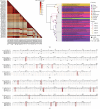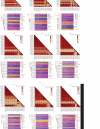Genomic Characteristics and Pathogenicity of Novel Reassortant Mammalian Orthoreoviruses From Sheep, China
- PMID: 40406227
- PMCID: PMC12097874
- DOI: 10.1155/tbed/6025244
Genomic Characteristics and Pathogenicity of Novel Reassortant Mammalian Orthoreoviruses From Sheep, China
Abstract
Mammalian orthoreoviruses (MRVs) have a wide geographic distribution worldwide and have been detected from humans and a variety of animal species. This study represents the first isolation of MRV from sheep rectal swabs in China, with analyses of its molecular and pathogenicity characteristics. MRV-positive samples were inoculated into Madin-Darby bovine kidney (MDBK) cells, resulting in stable cytopathic effects (CPEs) after three generations of blind passage. Two isolates were isolated and confirmed as MRV, named MRV-XJ23 and MRV-sheep/SY13, through reverse-transcription polymerase chain reaction (RT-PCR), transmission electron microscopy, and indirect immunofluorescence assay (IFA). The viruses exhibited broad cellular tropism. Whole-genome sequences were obtained and subjected to homology and evolutionary analyses, revealing that MRV-XJ23 and MRV-sheep/SY13 belong to the MRV-1 serotype. Phylogenetic analyses demonstrated that MRV-XJ23 is a reassortant virus containing gene segments from three MRVs that infected humans, bovines, and bats, with nucleotide homology exceeding 94.56%. The gene segments of MRV-sheep/SY13 were derived from five strains-Osaka2005, BatMRV-2/SNU1/Korea/2021, T1/human/Netherlands/1/84, IND/MZ/3013814/reo, and B/03-with nucleotide homology exceeding 95.47%. Animal experiments demonstrated that MRV-sheep/SY13 infection induced significant pathological changes in the respiratory and digestive tracts of mice. In sheep, MRV-sheep/SY13 caused respiratory infections, but no obvious lesion was observed from the digestive tract. This study expands our understanding of the MRV host range, reveals the potential public health risk of MRV transmission across species and zoonotic transmission, and underscores the necessity of further studies on epidemiology, reassortment patterns, and pathogenicity of MRV in sheep and domestic animals.
Keywords: mammalian orthoreoviruses (MRVs); pathogenicity; reassortment; sheep; virus isolation and identification.
Copyright © 2025 Xia Li et al. Transboundary and Emerging Diseases published by John Wiley & Sons Ltd.
Conflict of interest statement
The authors declare no conflicts of interest.
Figures







References
-
- Attoui H., Biagini P., Stirling J., et al. Sequence Characterization of Ndelle Virus Genome Segments 1, 5, 7, 8, and 10: Evidence for Reassignment to the Genus Orthoreovirus, Family Reoviridae. Biochemical and Biophysical Research Communications . 2001;287(2):583–588. doi: 10.1006/bbrc.2001.5612. - DOI - PubMed
-
- Singh F., Rajukumar K., Senthilkumar D., et al. First Report on Co-Isolation and Whole-Genomic Characterisation of Mammalian Orthorubulavirus 5 and Mammalian Orthoreovirus Type 3 From Domestic Pigs in India. Archives of Virology . 2022;167(7):1529–1545. doi: 10.1007/s00705-022-05459-x. - DOI - PubMed
MeSH terms
LinkOut - more resources
Full Text Sources

